Skewered dumplings made with rice flour and glutinous rice flour, Hanami Dango are popular snacks enjoyed during cherry blossom viewing in Japan. These chewy dumplings in three colors (sanshoku dango) come in pink, white, and green springtime hues. With just a touch of sweetness, this traditional Japanese confectionery announces the arrival of spring. {vegan friendly}
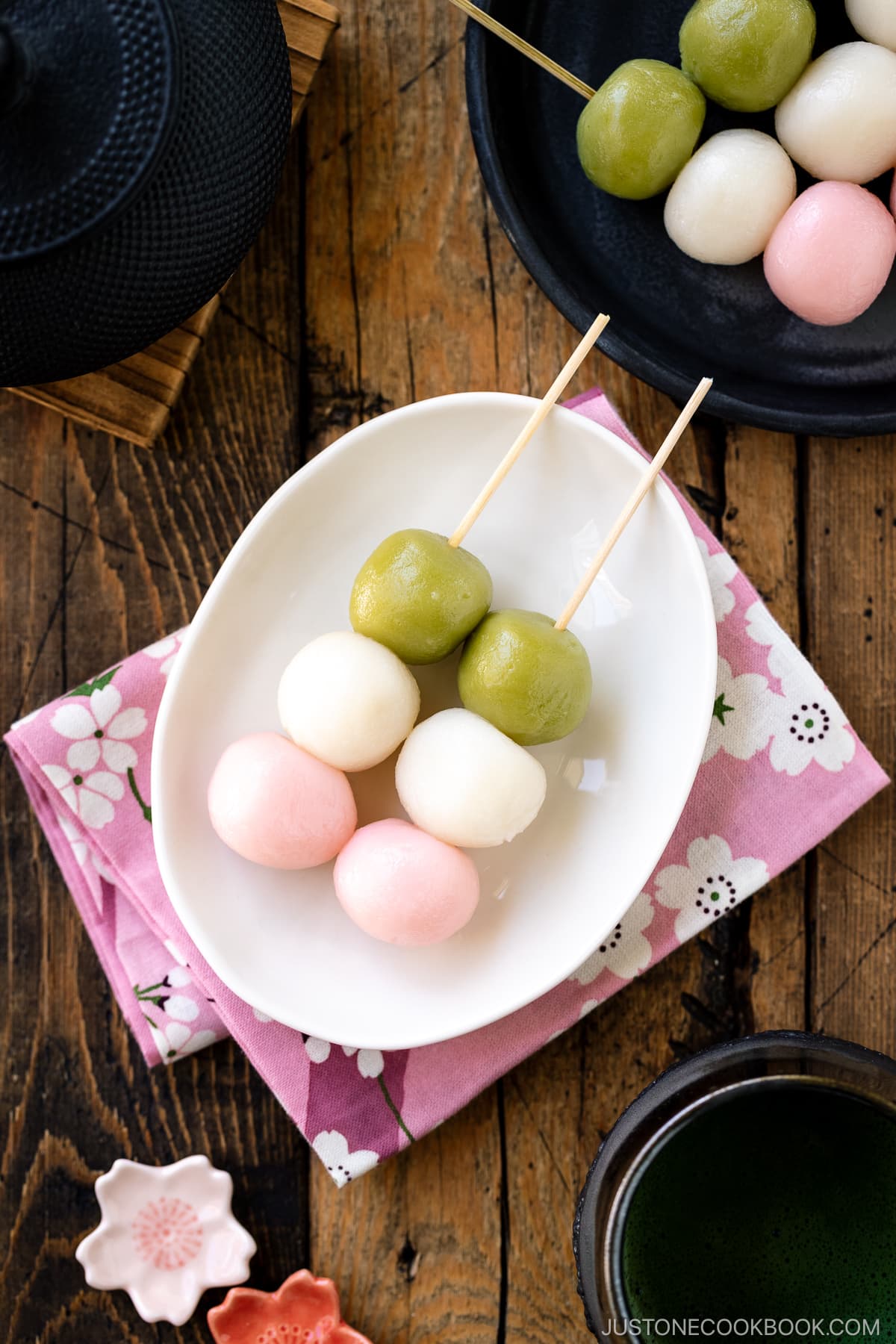
As spring approaches, Japan turns into a shade of pink. It is a time of renewal of life and beauty, and we celebrate this turn of the season with cherry blossom viewing (or Hanami in Japanese). A tradition that dates back as early as the 8th century.
During the cherry blossom viewing, the Japanese also enjoy different types of wagashi (traditional confectionery) including Hanami Dango (花見団子).
Table of Contents
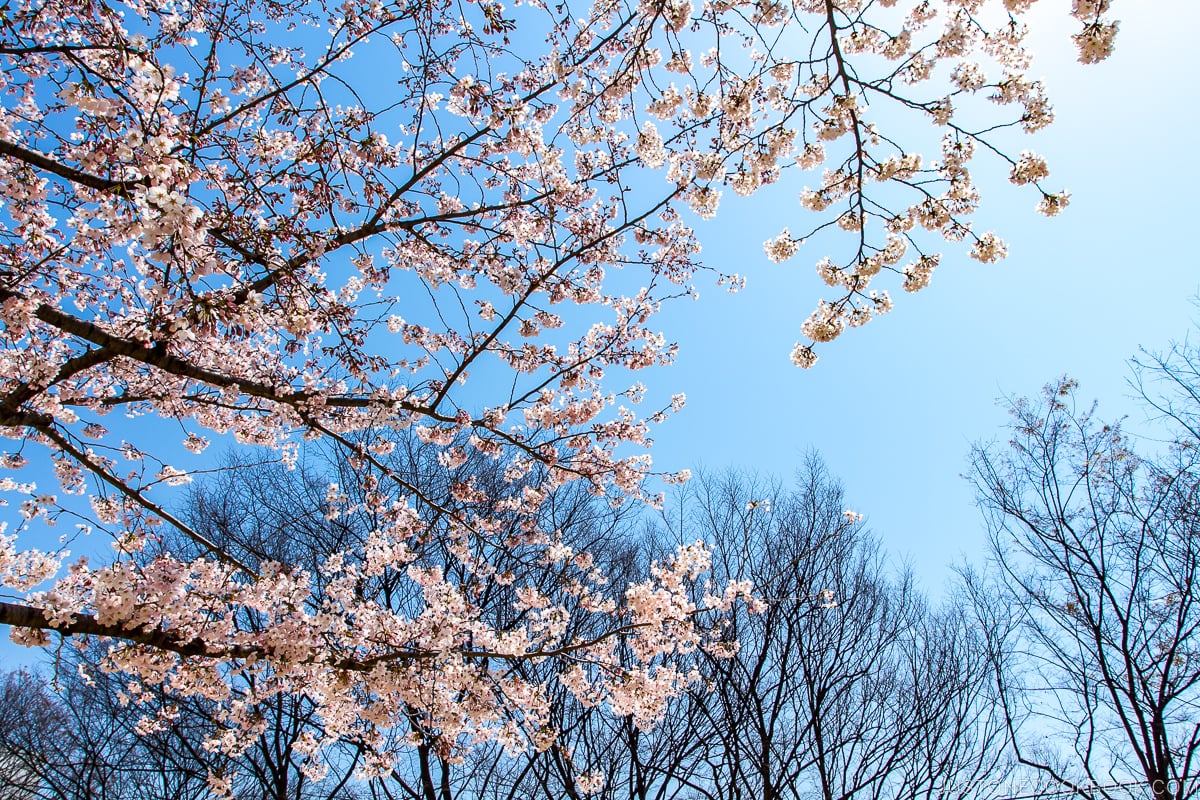
What is Hanami Dango?
Dango (団子) is a Japanese skewered sweet dumpling made with rice flour and glutinous rice flour.
Hanami (花見) means flower viewing (of cherry blossom), and during this season, many people go out for strolls through the magnificent columns of the flowering trees.
The Japanese have long celebrated and admired the beauty of cherry blossoms by having picnics beneath the blooms. At the picnics, we enjoy spring-themed foods in bento and wagashi which often incorporate seasonal flavors.
One of the popular sweets you can find at pop-up food stalls during the cherry blossom season is hanami dango (花見団子). The dumplings come in pink, white, and green springtime hues, so they are also called sanshoku dango (三色団子).
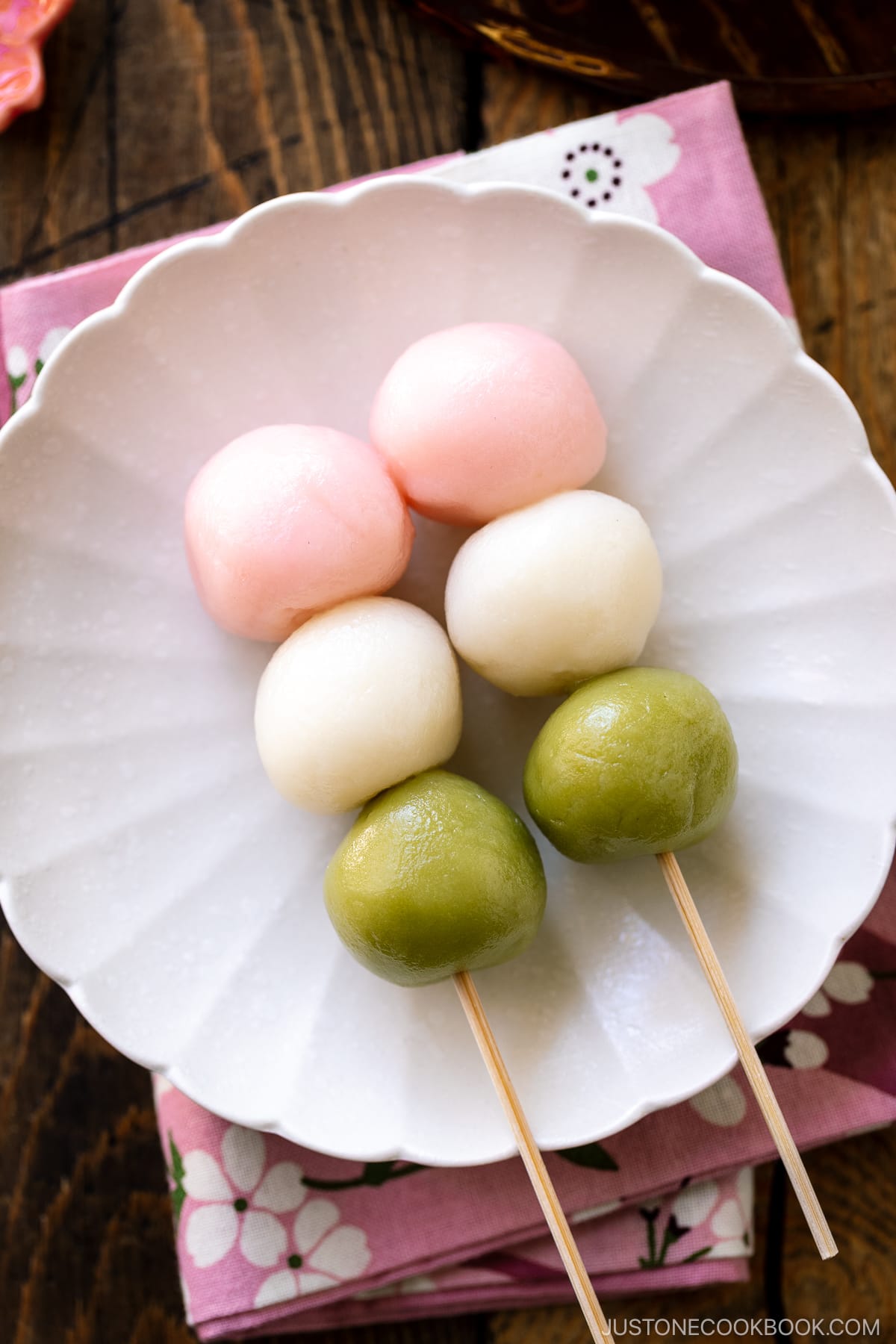
Why Pink, White, and Green Colors?
There are a few theories on why the hanami dango is skewered in a particular order of pink, white, and green from the top. Here are two popular theories:
- The life cycle of cherry blossoms: Pink buds, white flowers, and then green leaves.
- The scenery of the spring arrival: Red sun or pink cherry blossoms, leftover snow, and yomogi (mugwort) or green sprouts beneath the snow.
Which theory do you think is correct? They both sound good to me as the hanami dango brings happiness in the spring season.
History of Hanami Dango
The history of hanami dango overlaps with the history of cherry blossom viewing.
The ritual started to emerge when Toyotomi Hideyoshi served his guests hanami dango as a tea confectionery at the cherry blossom viewing party called Daigo no Hanami, which was held at Daigoji Temple in Kyoto on March 15, 1833.
Until then, cherry blossom viewing was not a party where people enjoyed food and drink, but more like an aristocratic pastime composing songs and enjoying dances and music. From this point on, the custom of eating and drinking while admiring the blossoms became widespread among the common people, and hanami dango came to be an indispensable Japanese confectionery for cherry blossom viewing.
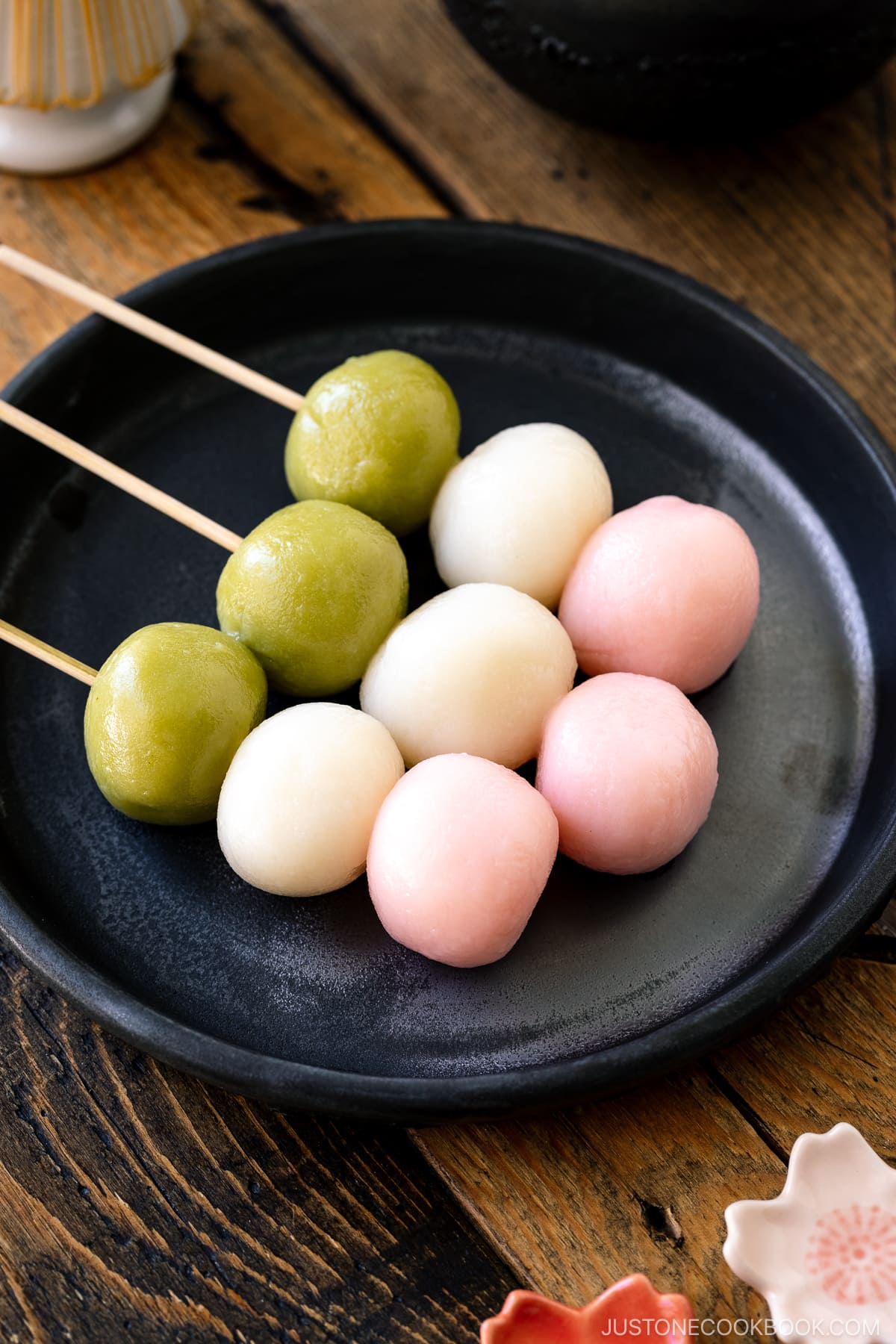
Ingredients for Hanami Dango
I will talk about the types of rice flour in the section below, but here are the ingredients you’ll need to make the authentic hanami dango.
- Joshinko (上新粉) – Japanese short-grain rice flour
- Shiratamako (白玉粉) – Japanese short-grain glutinous rice flour, also known as sweet rice flour
- Sugar – I use granulated sugar
- Red food coloring – I use powder kind, but you can use gel
- Matcha (green tea powder) or yomogi (mugwort)
How to Make Hamami Dango
Find the recipe card below for detailed instructions.
Jump to Recipe- Mix the joshinko, shiratamako, and sugar in a bowl.
- Gradually add the measured boiling water and mix until well combined.
- Divide the dough into thirds. Then, color one dango ball with a little bit of red food coloring and the next one with matcha (or yomogi). Keep the last one plain.
- Divide each dough into 6 equal pieces and shape them into a nice, round ball.
- Cook the dumplings (dango) in boiling water. Then, skewer the dumplings onto a bamboo skewer. Serve immediately.
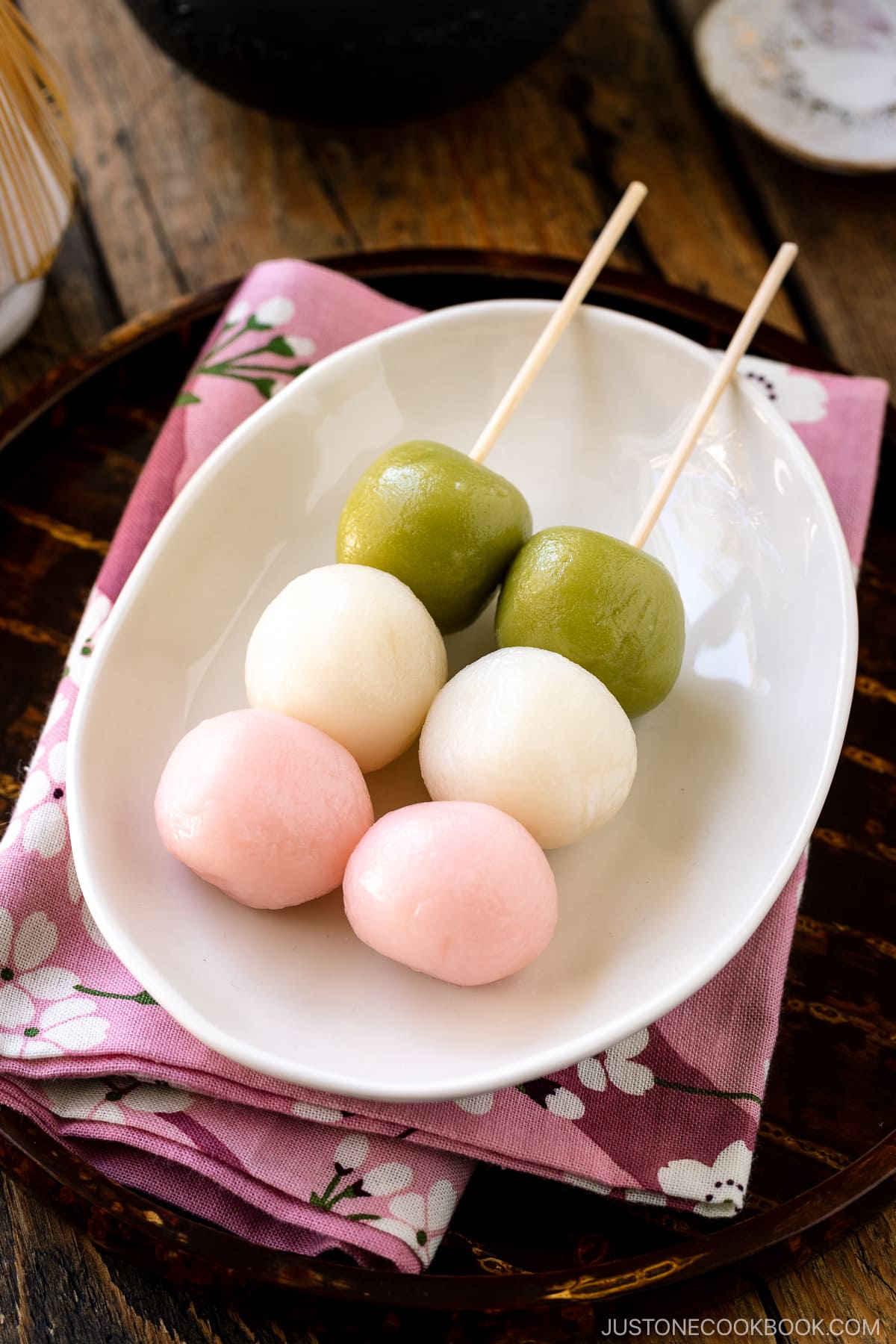
Learn Different Types of Rice Flour
If you never made dango or mochi desserts, you might not be familiar with the different types of rice flour used in Japanese desserts. In this section, let’s talk about four different types of Japanese short-grain rice flour and glutinous rice flour.
- Joshinko (上新粉)
- Shiratamako (白玉粉)
- Mochiko (餅粉)
- Dangoko (団子粉)
Joshinko and Shiratamako
Dango (だんご, 団子) is traditionally made with joshinko (上新粉) or short-grain rice flour, which is made of uruchimai (うるち米). This is why dango and mochi are different as mochi is made with glutinous rice or glutinous rice flour, which is made of mochigome (もち米).
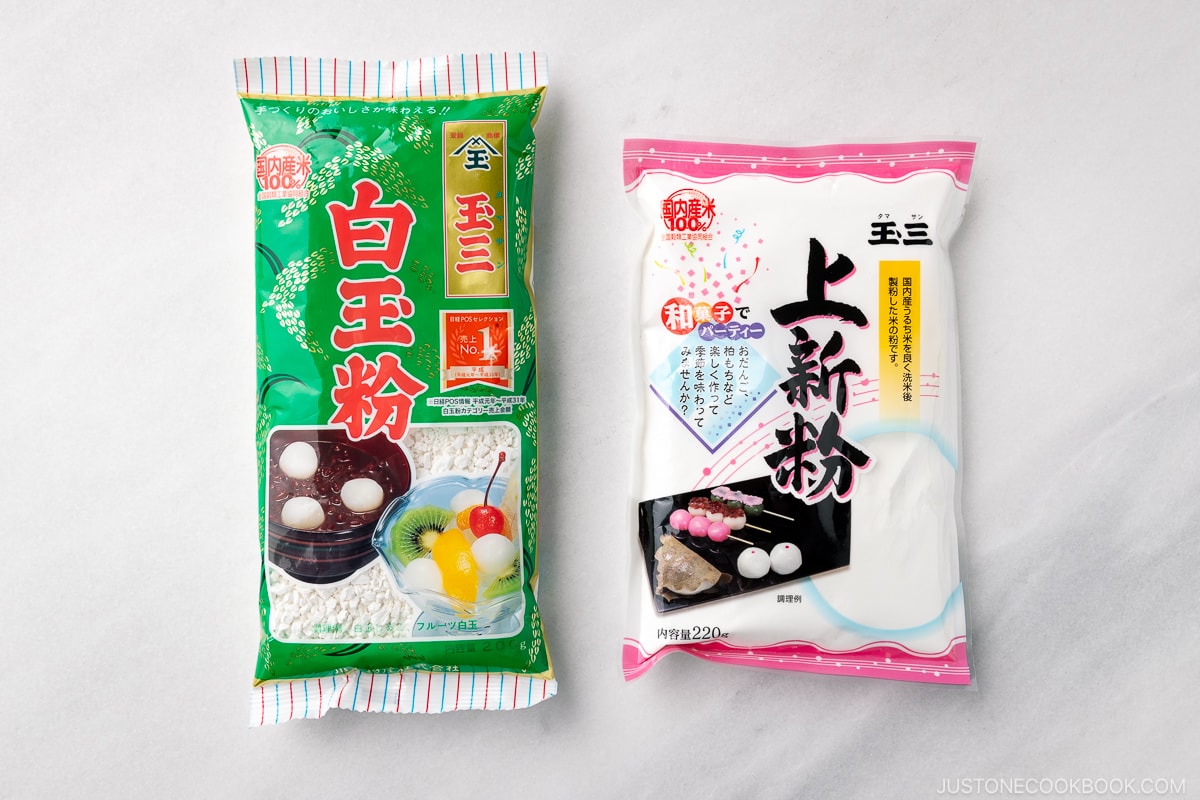
I find dango made only with joshinko a bit too chewy and tough. So when I make dango at home, I always mix both rice flour and glutinous rice flour to achieve the perfect texture for the dango.
- Johshinko (上新粉) – The rice flour made from short-grain rice (uruchimai うるち米). Buy from Amazon.
- Shiratamako (白玉粉) – The gluteinous rice flour made from short-grain glutinous rice (mochigome もち米). Even though it’s called “flour,” it’s more like coarse granules. Buy from Amazon.
My recommendation is an equal proportion: 50% rice flour and 50% glutinous rice flour. The combination will give you a bouncy, chewy texture, but it won’t be too sticky like mochi. You can do 40% rice flour and 60% glutinous rice flour if you prefer a softer, mochi-like texture.
🚨 Please remember that all these flours are made from Japanese short-grain rice. The glutinous rice flour found in Asian grocery stores is typically made from long-grain rice. Our readers have told us that they don’t yield the same result because the texture and flavor are quite different. Where do we find Japanese short-grain ones? You can purchase them on Amazon (link above) or from well-stocked Japanese grocery stores.
Mochiko
The best substitute for shiratamako is mochiko, which is widely available in the U.S. You can buy it on Amazon or even in American grocery stores.
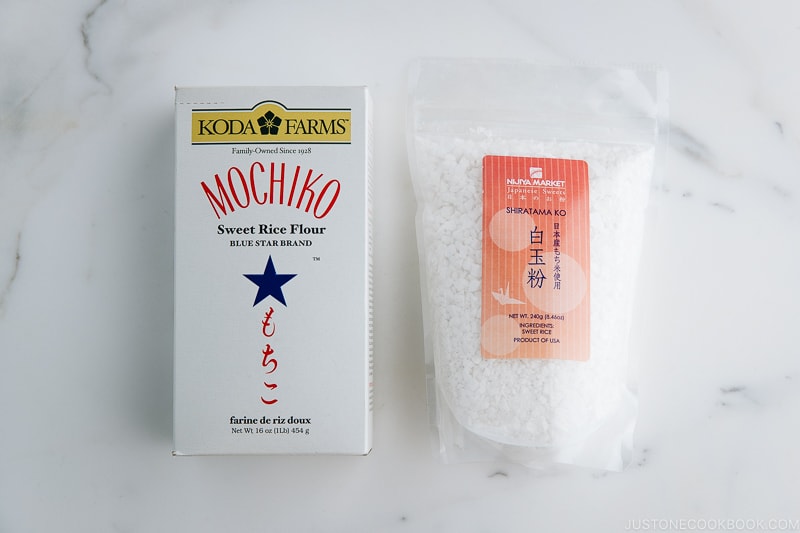
Although shiratamako and mochiko are both “glutinous rice flour” (also called “sweet rice flour”), the results are slightly different, especially in texture and flavor. Shiratamako yields a smooth, more refined, and chewy/bouncy texture while mochiko yields a soft, elastic texture and a bit bland taste.
Most Japanese recipes use shiratamako over mochiko for a superior texture and flavor.
Dangoko (Dango Flour)
At the Japanese grocery store, you may find another type of flour called dangoko (団子粉). This is a combination of rice flour and glutinous rice flour, but the ratio is unknown (up to the manufacturer).
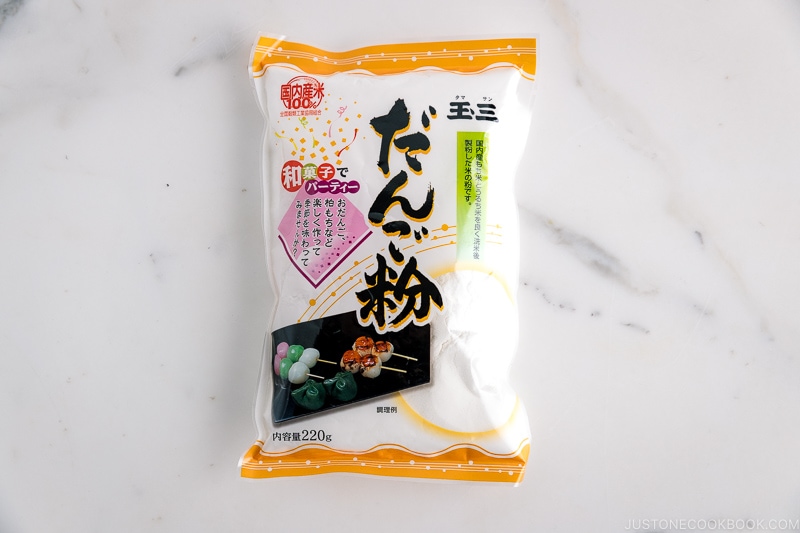
If you have trouble finding both joshinko and shiratamako to make your own 50/50 blend (like I showed in my recipe), buying a package of dangoko is a great alternative. However, in my opinion, the texture of the dango is firmer. This is probably because the blend uses more rice flour than glutinous rice flour instead of 50/50.
Use These Bamboo Skewers for Dumplings
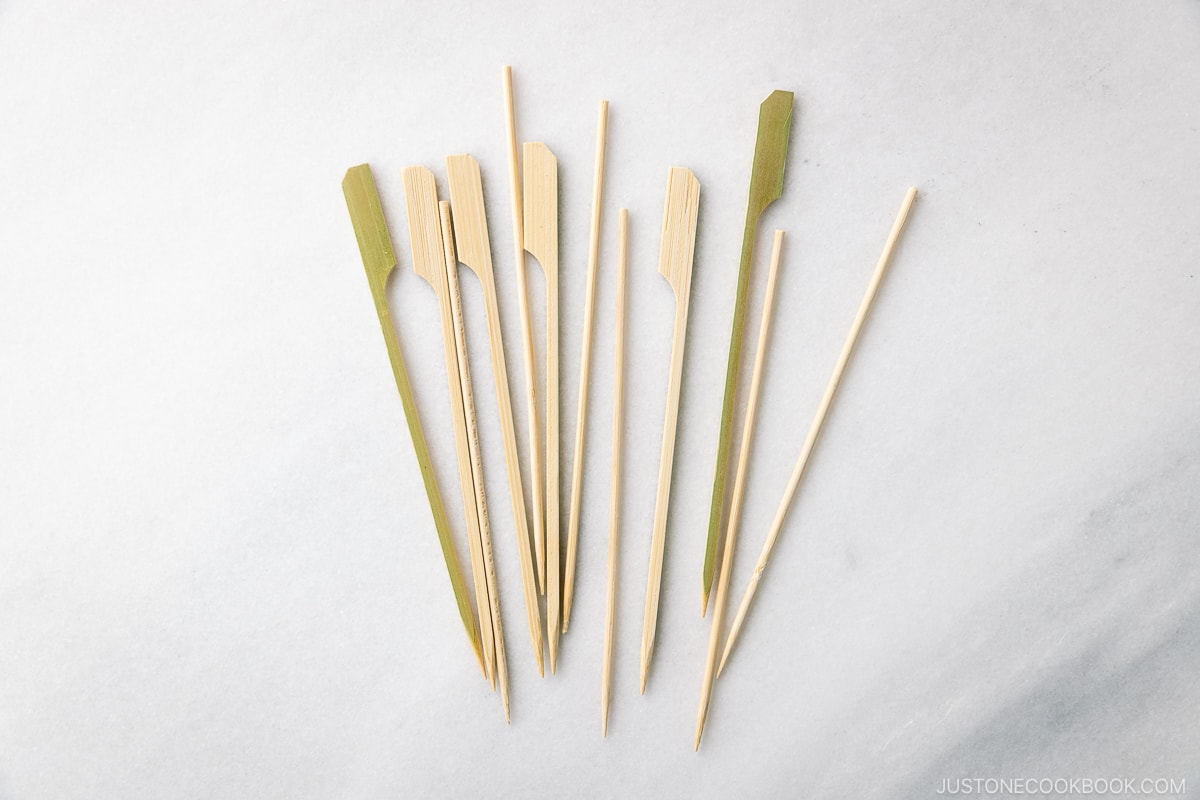
You will need 6-inch (15 cm) bamboo skewers. If you already have longer skewers at home, you can trim them down to 6-inch pieces. There are two types: round skewers and square skewers with a paddle. I use round skewers for this recipe.
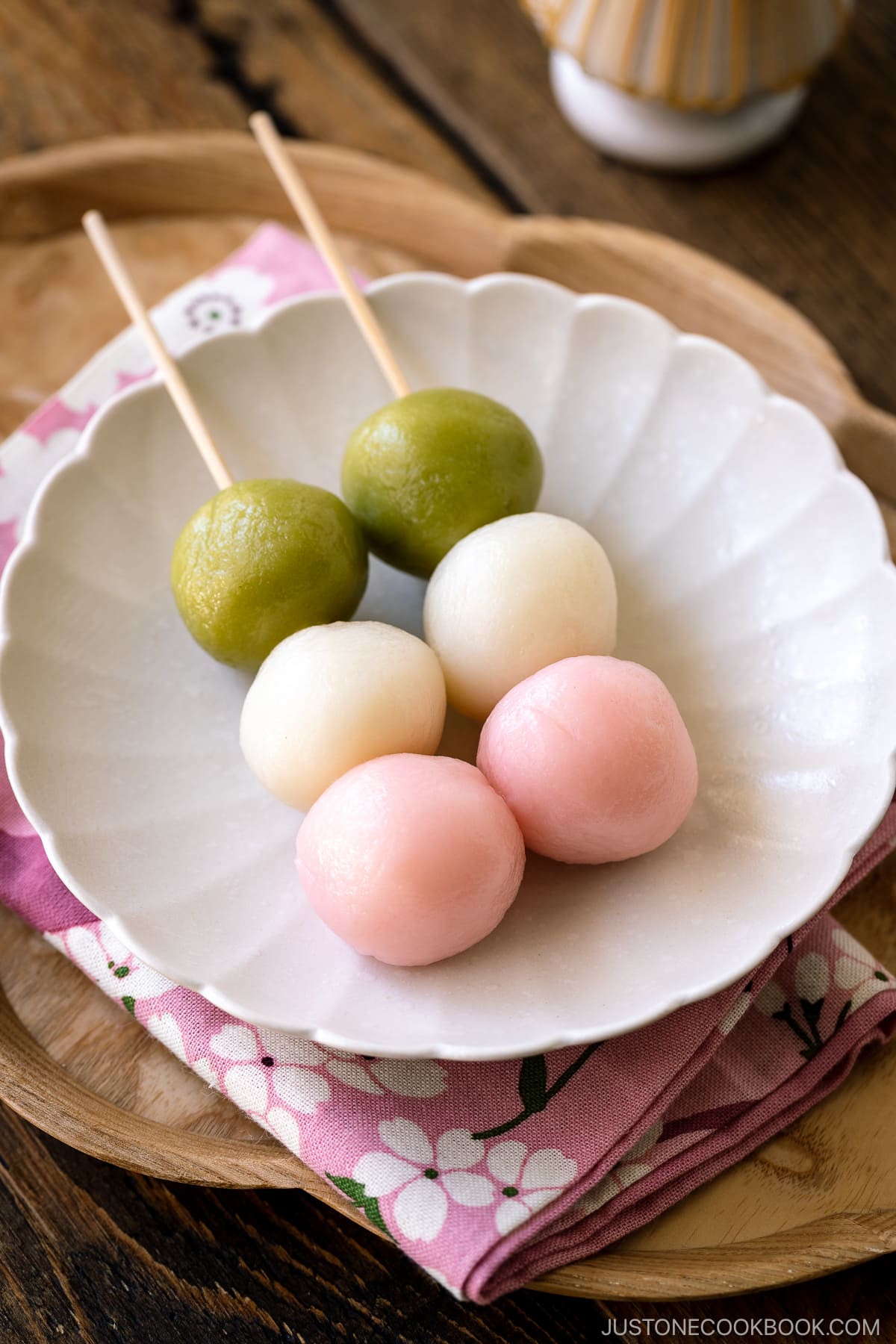
How to Color the Dumplings in Pink and Green
The Pink Dumplings
Traditionally the pink dumplings were colored using purple shiso (赤紫蘇), salt-pickled cherry blossoms, or fruit of cape jasmine (kuchinashi クチナシ). These natural food coloring options can be harder to access outside of Japan.
So for this recipe, I like using powdered food coloring as I can have better control when I add it to the food. I used this powdered food coloring I bought from Amazon.
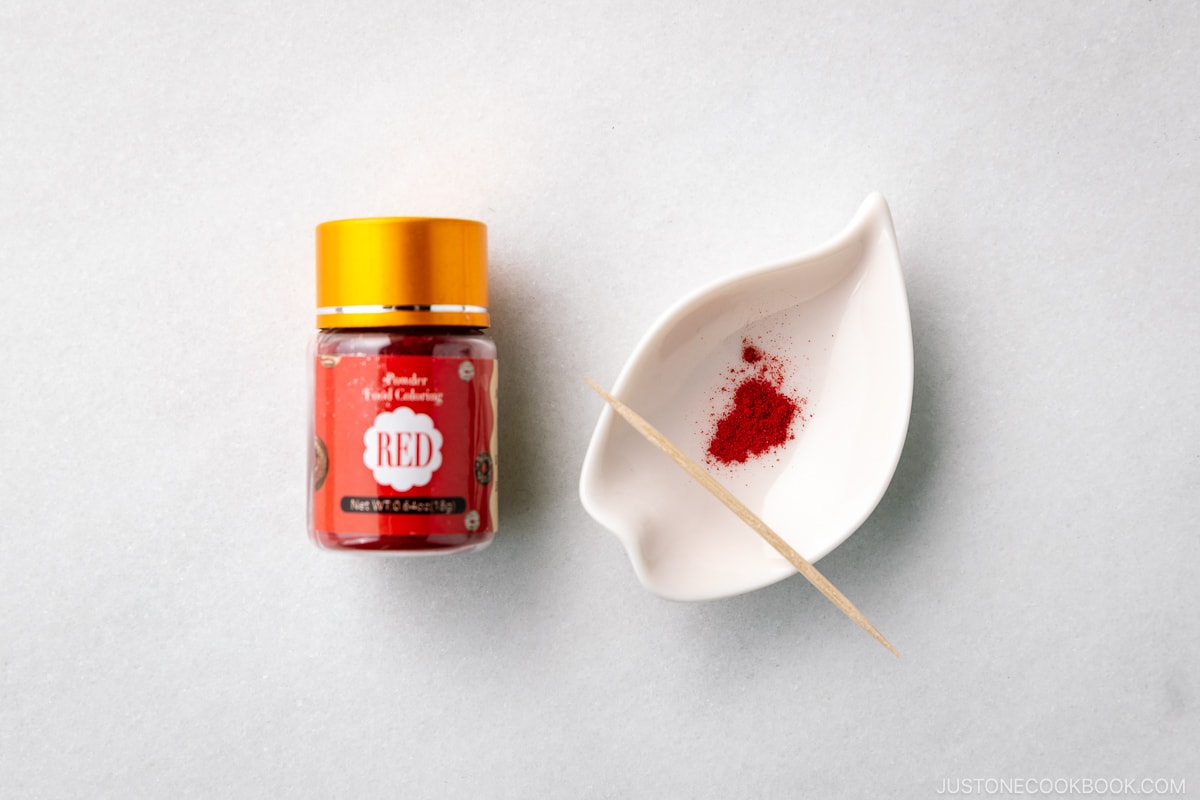
If you prefer natural food coloring, I recommend using beet juice or ground freeze-dried strawberry/raspberry to dye the dumplings pink.
The Green Dumplings
The green dumplings are flavored and colored traditionally with yomogi or mugwort in Japan. It’s probably hard to find yomogi outside of Japan but you can purchase this yomogiko (mugwort powder) on Amazon.
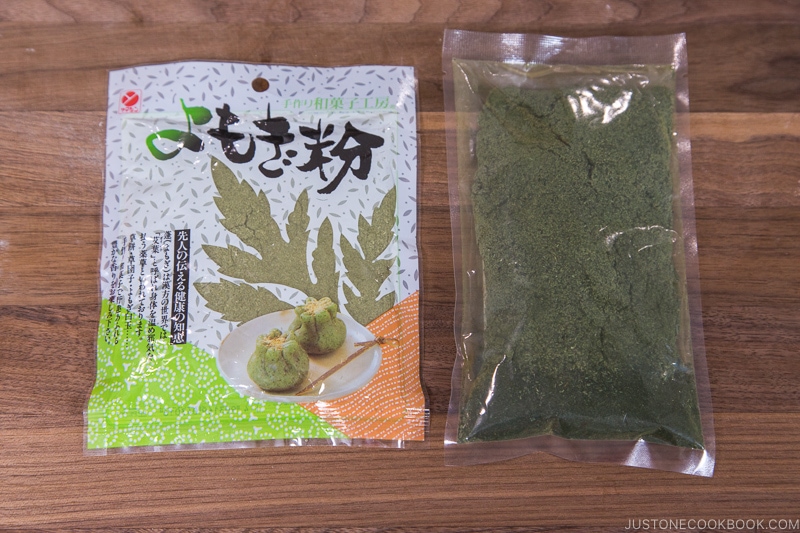
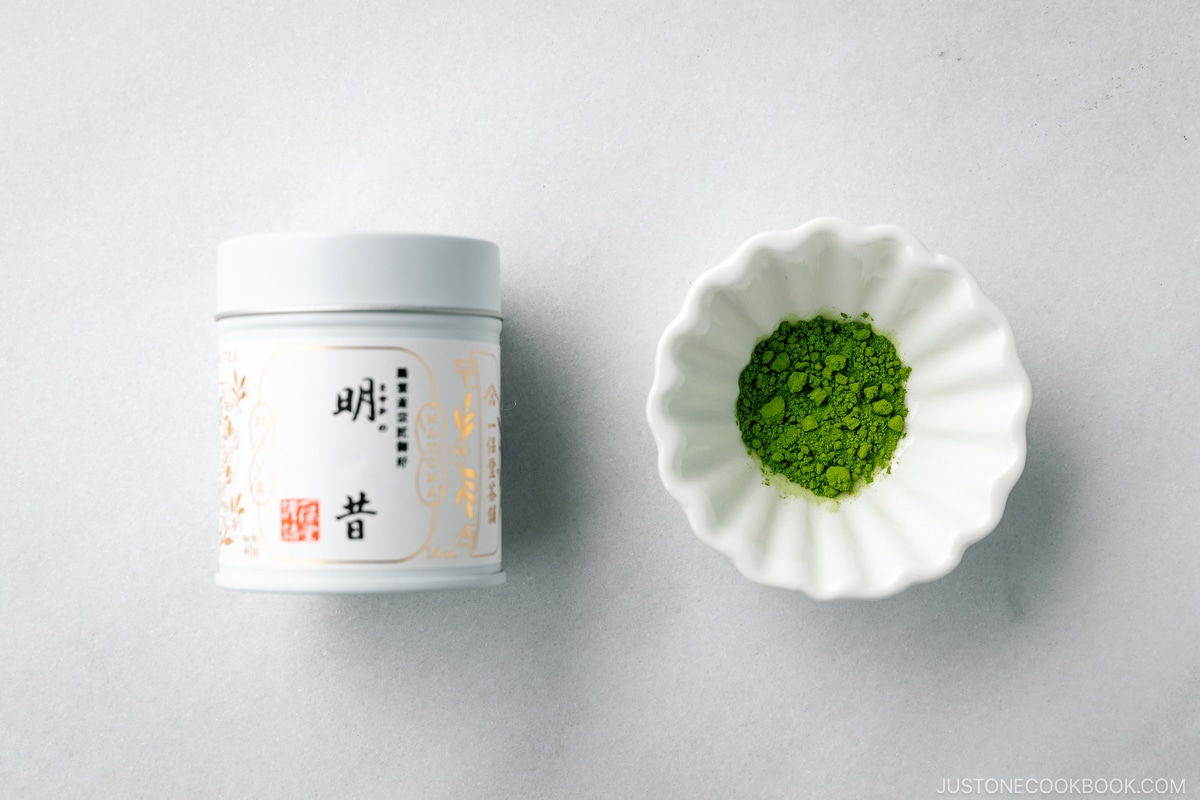
For this recipe, I used matcha powder (green tea powder) so it’s much easier to make. My favorite tea shop, Ippodo Tea from Kyoto, sells matcha you can get on Amazon.
How to Enjoy Hanami Dango
Hanami dango is enjoyed by itself without any toppings or sauce. If you have never tried this Japanese traditional sweet, you may find it a bit bland.
If you like, enjoy these dumplings with anko (sweet red bean paste).
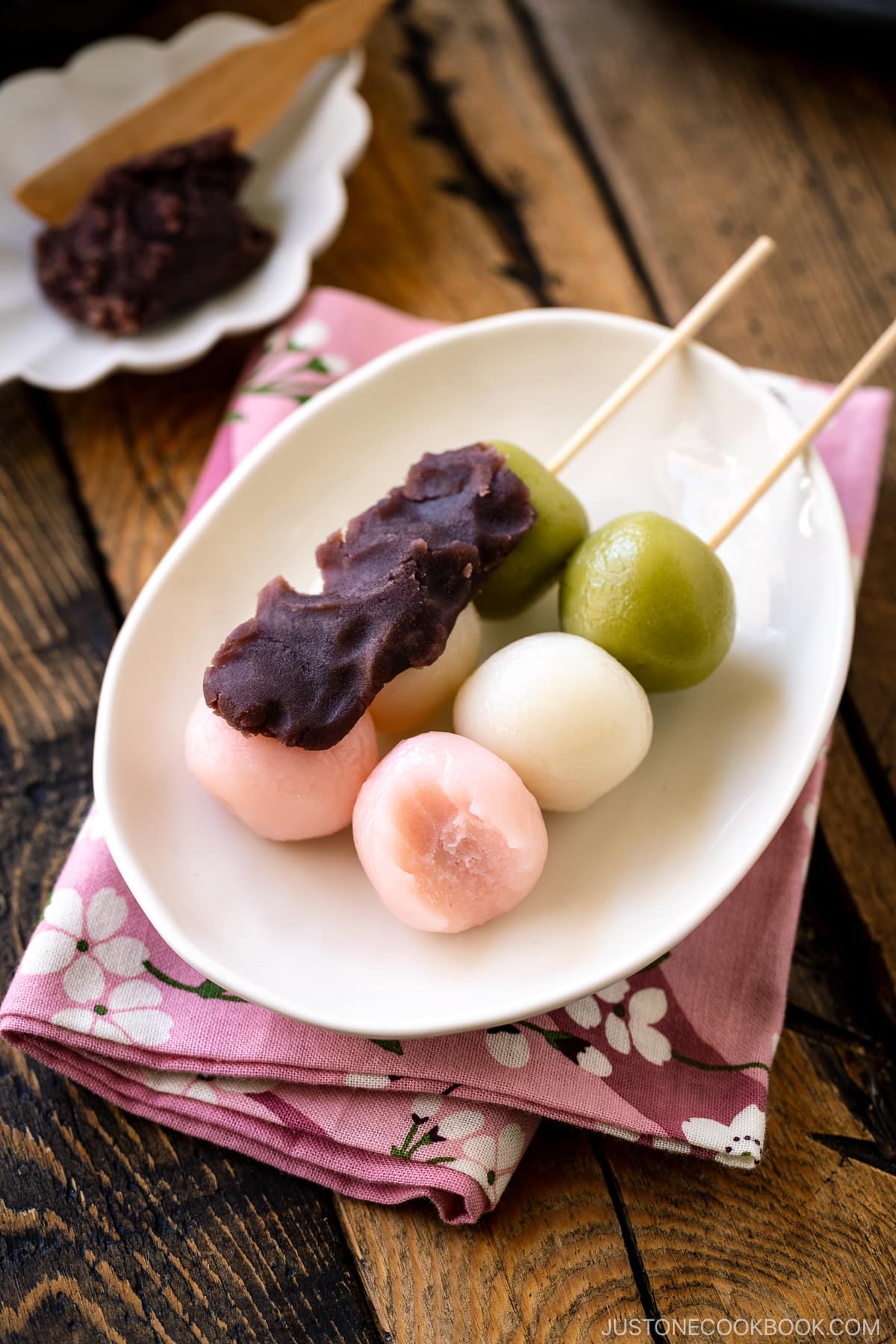
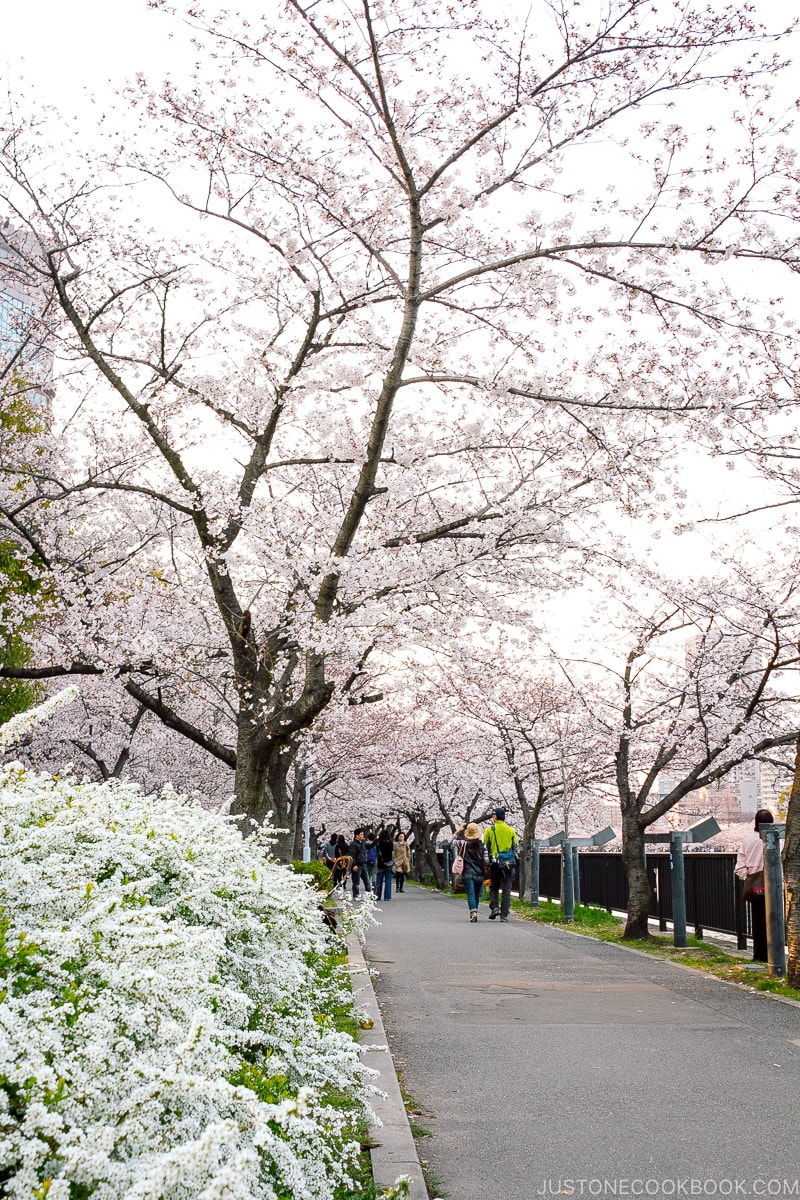
Have you heard of the Japanese expression or proverb “Hana yori dango” (花より団子)? It means “dumplings over flowers” and is used to describe someone who values practicality and substance over-refinement and appearance.
Are you the person who comes to see cherry blossoms and is more interested in eating hanami dango than in admiring flowers? I am!
Other Delicious Japanese Sweets
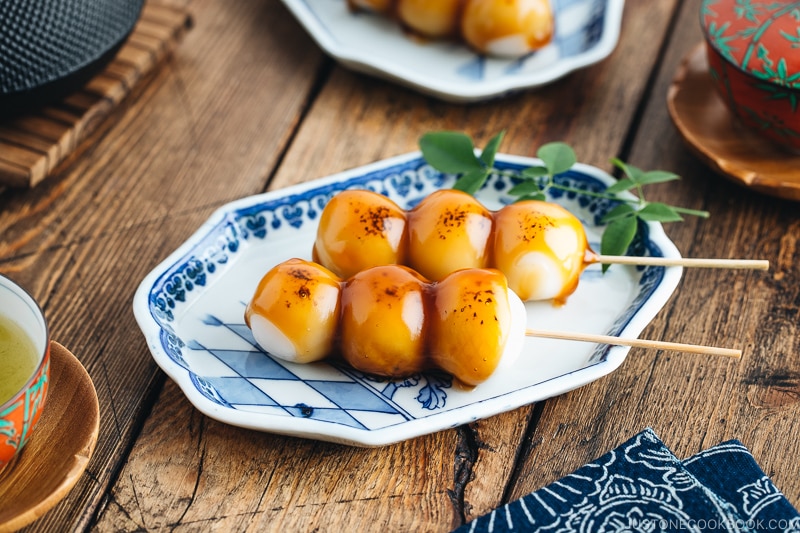
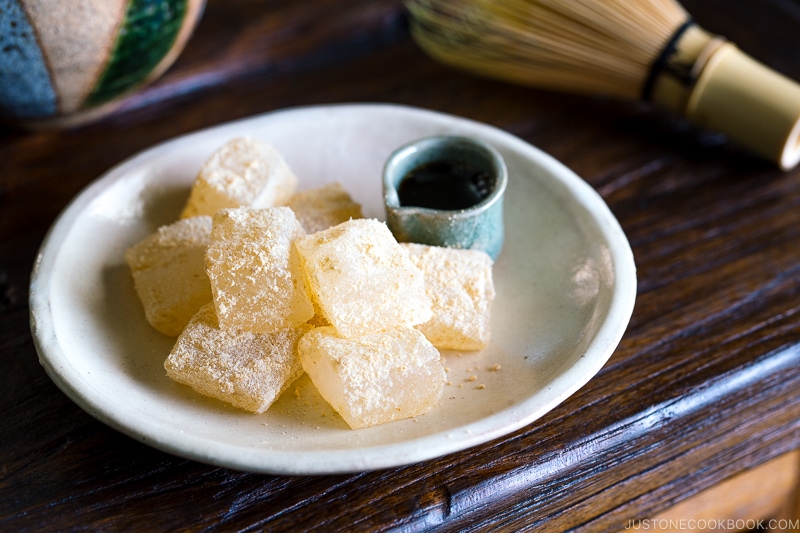
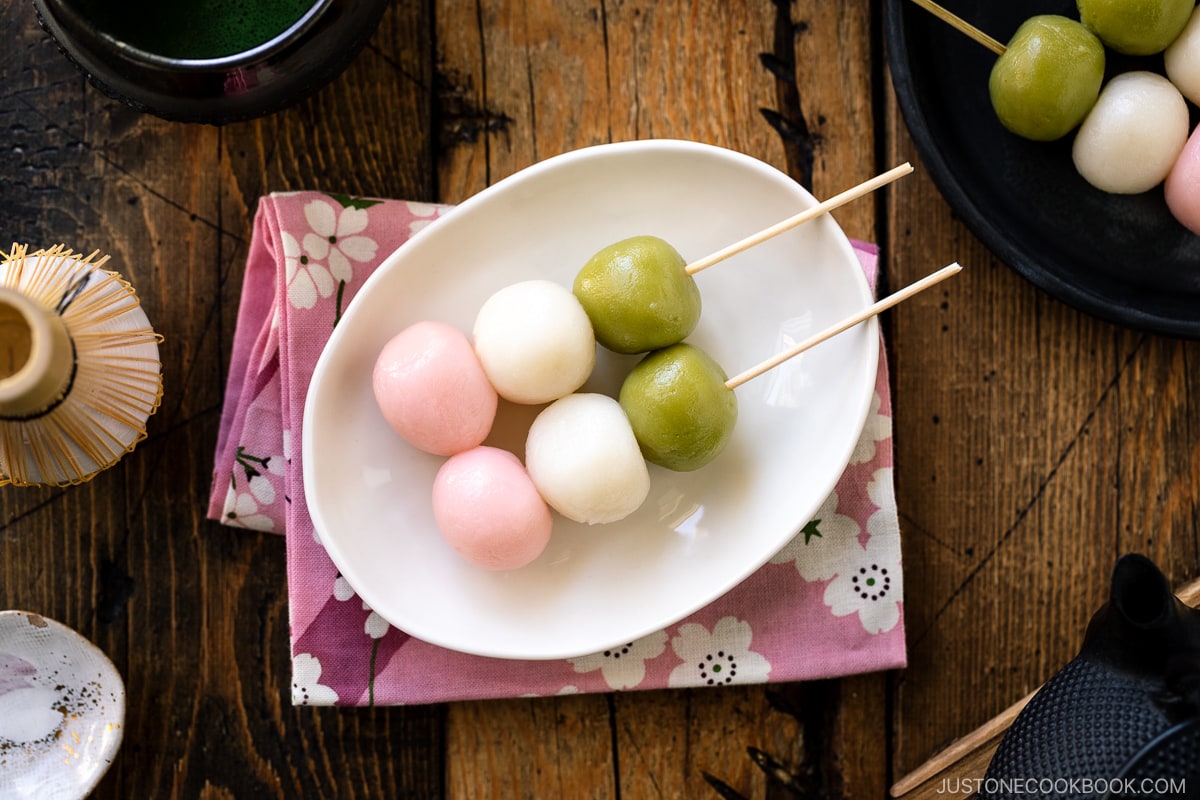
Wish to learn more about Japanese cooking? Sign up for our free newsletter to receive cooking tips & recipe updates! And stay in touch with me on Facebook, Pinterest, YouTube, and Instagram.
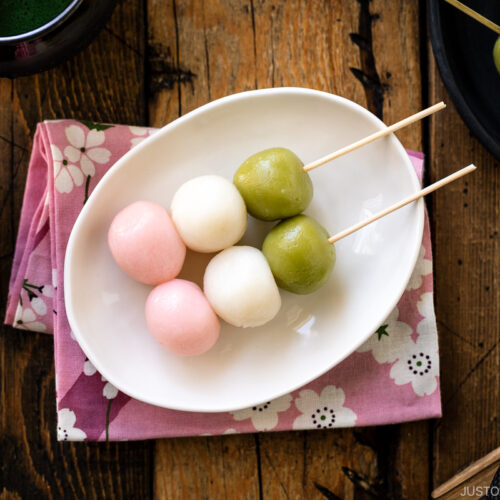
Hanami Dango
Video
Ingredients
For the Dumplings Using Joshinko and Shiratamako
- ⅔ cup joshinko (Japanese rice flour) (上新粉; this is short-grain rice flour, different from other Asian varieties; you can buy it from Amazon)
- ¾ cup shiratamako (glutinous rice flour/sweet rice flour) (白玉粉; this is short-grain glutinous rice flour, different from other Asian varieties; you can buy it from Amazon; you can substitute with mochiko)
- ⅓ cup sugar (the sugar helps the dango stay softer and gives it a mild, subtle sweetness)
- ⅔ cup boiling water (joshinko requires boiling water)
For Coloring the Dumplings
- ¼ tsp matcha (green tea powder) (I love and use matcha from Ippodo)
- red food coloring (I use this powdered food coloring; if you prefer to use a natural ingredient, crush freeze-dried strawberries/raspberries)
For the Dumplings Using Dangoko (Optional)
- 7 oz dangoko (Japanese rice dumpling flour) (団子粉; you can find it at Japanese grocery stores)
- ⅔ cup water
For the Yomogi Dango Version (Optional)
- 1 Tbsp yomogi (mugwort) (you can buy it on Amazon)
- 2 Tbsp hot water
Instructions
- Gather all the ingredients. Soak the 6-inch (15-cm) bamboo skewers in water. You can start boiling a large pot of water on low heat. Once boiling, keep it on low heat.

To Make the Dough
- Combine ⅔ cup joshinko (Japanese rice flour), ¾ cup shiratamako (glutinous rice flour/sweet rice flour), and ⅓ cup sugar (or 7 oz dangoko (Japanese rice dumpling flour) and ⅓ cup sugar) in a large bowl.

- Using chopsticks, mix it all together until well blended. Next, add in ⅔ cup boiling water (or ⅔ cup water (cold) for the dangoko) a little bit at a time while mixing with chopsticks. Please note: You may not need to use the entire measured amount of hot water. If you add too much water, your dough will be too soft.

- The flours will start to stick together and eventually form clumps. When your dough reaches this stage, stop adding the water.

- Using your hands, combine the dough into one ball.

- Knead by hand until the dough becomes smooth. If needed, add a tiny bit of hot water to pick up any residue in the bowl (I did not use all the measured hot water).

- The texture of the finished dough should feel similar to an earlobe. The "texture of an earlobe" is such a funny description, but that’s how we check the consistency in Japan. The dough shouldn‘t be too soft. It‘s slightly on the dry side. Tip: If you add too much water, your dough will be too soft. If that happens, add more joshinko.

- Using a kitchen scale, weigh the dough. Using a bench scraper or knife, divide it into thirds. Put two of the pieces in separate bowls.

To Color the Dough
- To make the green dough, add ¼ tsp matcha (green tea powder) to the dough in one of the bowls. Using a silicone spatula (or your hand), mix the matcha into the dough until well blended.

- If you want to adjust the color, add a very small amount. Make sure all the powder is incorporated and check the color before you add more matcha.

- For the pink dough, add a very tiny bit of red food coloring powder to the dough in the other bowl. I used a toothpick to pick up the coloring powder and you can see from the image how little I scooped. With a different (clean) silicone spatula, mix the food coloring into the dough until well blended. Tip: Don’t add too much food coloring or the color will be too strong and intense; you want it to be a soft, pale, pastel pink.

- You can see that I added slightly more red food coloring to get the right shade of pink. Tip: If the dough is getting too dry, dip your spatula in water and mix the dough (instead of drizzling water into the dough).

To Form the Dumplings
- Take the white dough and roll it into a cylinder. Using the bench scraper or knife, divide the dough into 6 equal pieces.

- Roll a piece of white dough between your hands into a smooth, round ball. Tip: If the dough is cracking or wrinkled, dip the tip of your finger in water and apply a small amount to the cracked area to smooth it out.

- When you are done making a nice ball shape, continue with the rest of the dough pieces.

- Next, take the green dough and roll it into a cylinder. Divide the dough into 6 equal pieces.

- Roll a piece of green dough between your hands into a smooth, round ball. Continue with the rest of the dough pieces.

- Finally, take the pink dough and roll it into a cylinder. Divide the dough into 6 equal pieces.

- Roll a piece of the pink dough between your hands into a smooth, round ball. Continue with the rest of the dough pieces.

- Now, the dumplings are ready to boil.

To Cook the Dumplings
- Prepare a bowl of iced water just before cooking the dumplings. First, we will cook the light-colored white and pink dumplings. Once the water in the pot is boiling, quickly re-roll each white or pink dumpling into a nice, round ball before you gently drop them into the pot. Stir the balls occasionally so they don’t stick to the bottom of the pot.

- Cook the dumplings until they start floating, about 7–8 minutes. The dumplings will stay near the bottom of the pot at first, but they will float once they are cooked. When they rise to the top, boil them for an additional 1 minute.

- Remove the white and pink dumplings from the pot and immediately place them in iced water for 15–30 seconds so they stop cooking and are cool enough to handle. Then, drain them well and transfer to a plate or tray moistened with water. Tip: Don‘t keep the dumplings too long in the iced water or they will get hard. Also, wet the plate or tray so the dumplings don‘t stick.

- Next, work on the green dumplings and repeat the same process. As you see, the boiling water changes color, so I recommend starting with the light-colored white and pink dumplings; don‘t cook all three colors at the same time.

- Remove the cooked green dumplings from the pot and immediately place them in iced water for 15–30 seconds to stop the cooking and cool slightly. Then, transfer to a plate moistened with water.

To Assemble the Hanami Dango
- Thread one dumpling of each color onto a skewer. Start with the green dumpling first, then a white dumpling next, and finish with a pink dumpling at the tip. For an ideal presentation, keep the tip of the skewer hidden within the pink dumpling. Continue with the rest of the skewers and set aside. Tip: If your hands get sticky from handling the moist dumplings, you can wash the starch off your hands from time to time.

To Serve
- Serve the Hanami Dango at room temperature. Since the Hanami Dango is rather mild tasting with just a touch of subtle sweetness, I sometimes serve it with sweet red bean paste (optional) on the side.

To Store
- Option 1: After you form the dough into round dumplings, you can store the uncooked dumplings in a single layer in an airtight container and freeze up to a month. When you use them, boil the frozen dango without defrosting.
- Option 2: After boiling and cooling the dumplings, pat them dry and pack them so they don't touch each other into an airtight container. Freeze for up to a month. When you use them, microwave or boil until they are warm.
- Option 3: Put the leftovers in an airtight container and keep at room temperature for up to 2 days. If you live in a hot climate, find a cool place to store it, but not in the refrigerator as the dango will become too tough. Enjoy it within 24–36 hours.
For the Optional Yomogi Dango Version
- To color the green dough using the more traditional yomogi dango version, use yomogi powder.

- Combine 1 Tbsp yomogi (mugwort) and 2 Tbsp hot water in a bowl and mix well together.

- Set aside for 5 minutes. Then, strain the yomogi using a fine-mesh strainer. Discard the liquid.

- Add the yomogi to the dough and knead well to combine.

Nutrition
Editor’s Note: This post was originally published on March 21, 2017. It was updated with the revised recipe and new images on March 12, 2023. It was republished with more helpful content on March 19, 2024.
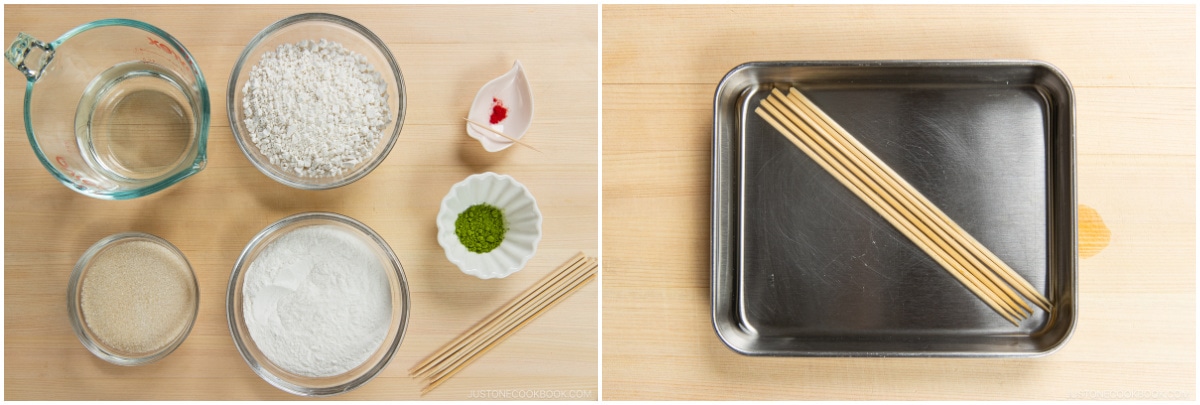
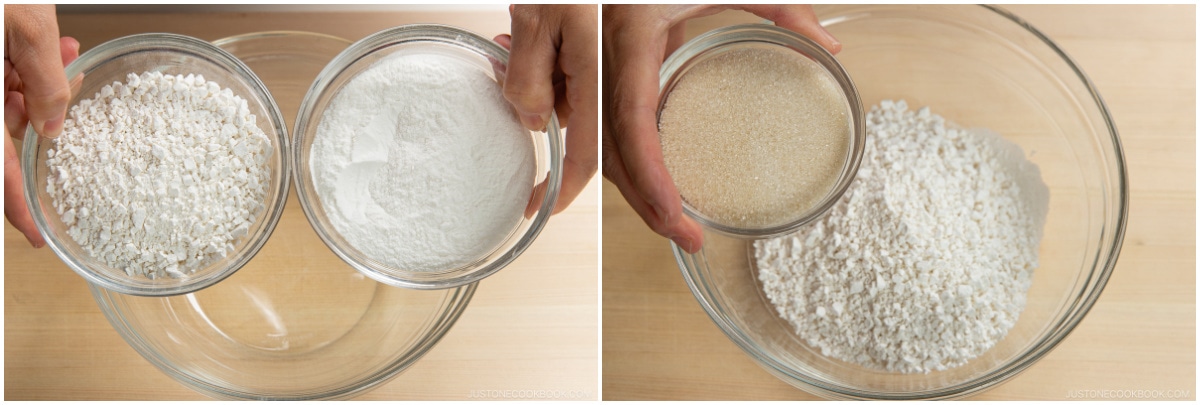
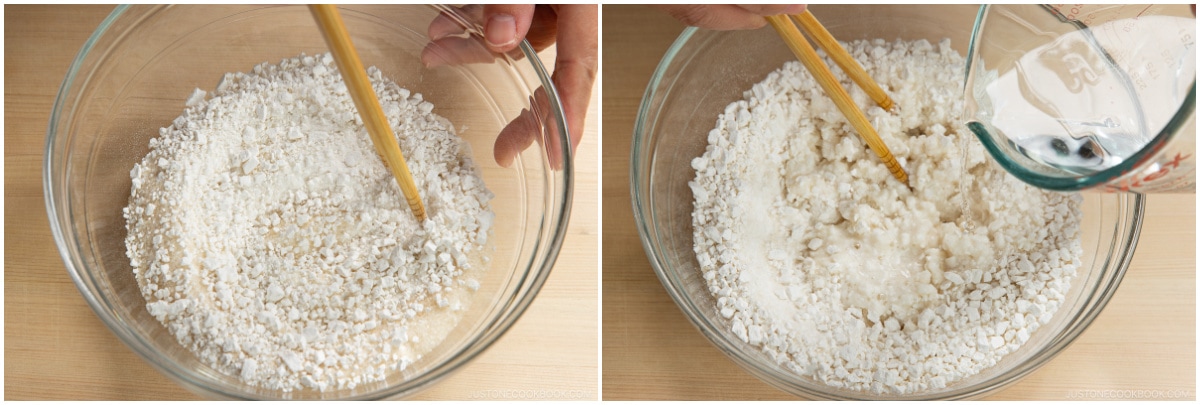
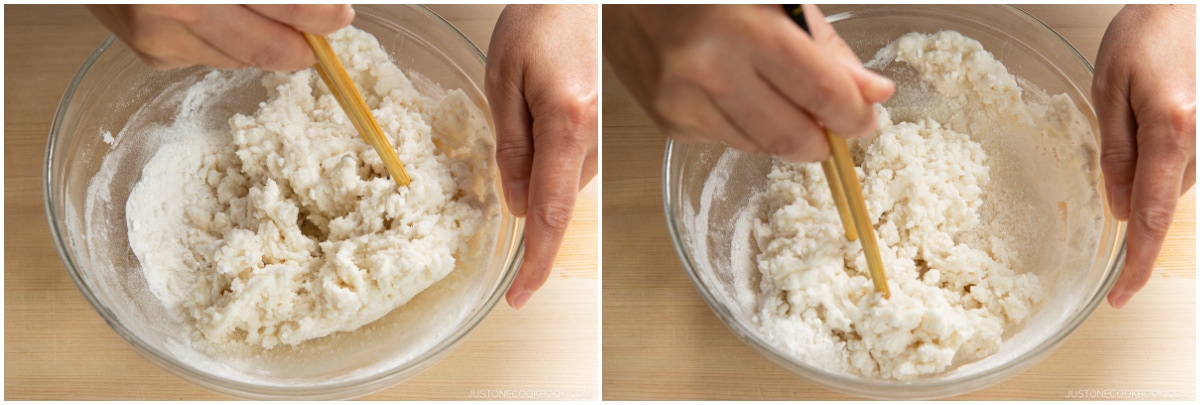

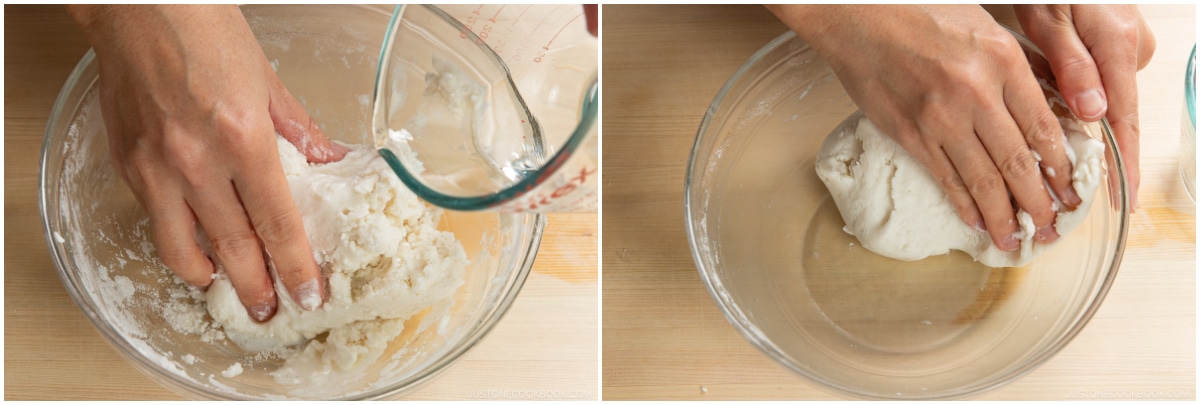
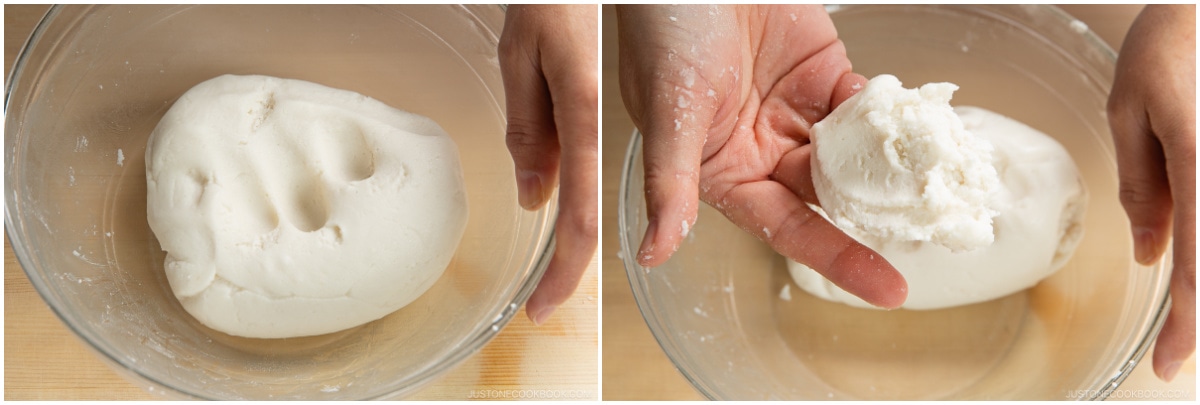
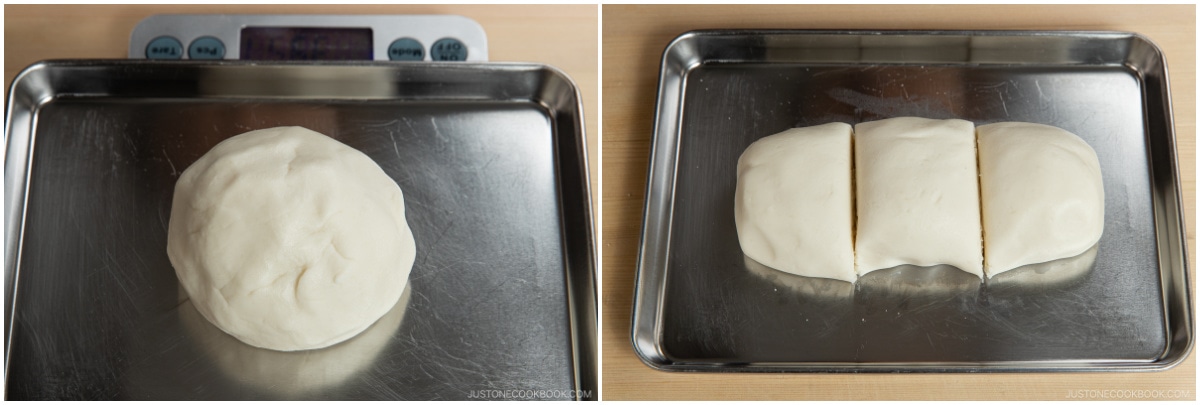

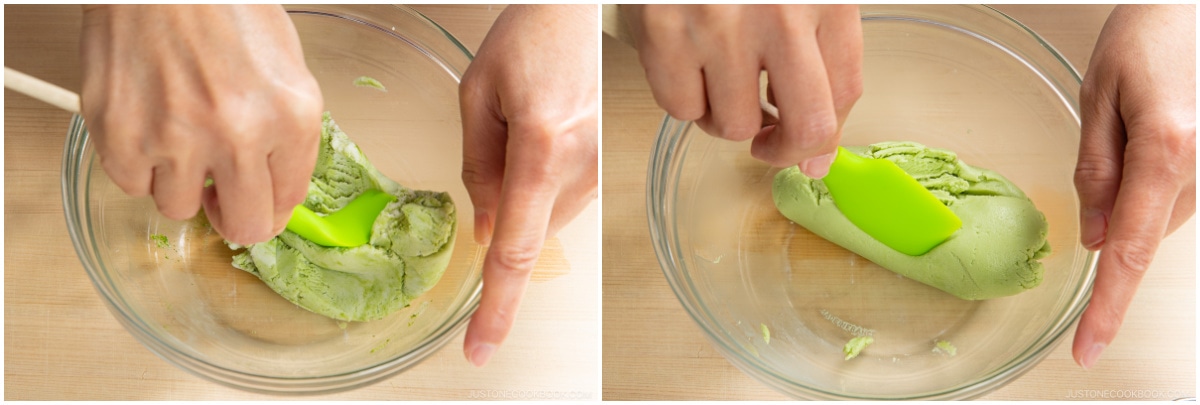
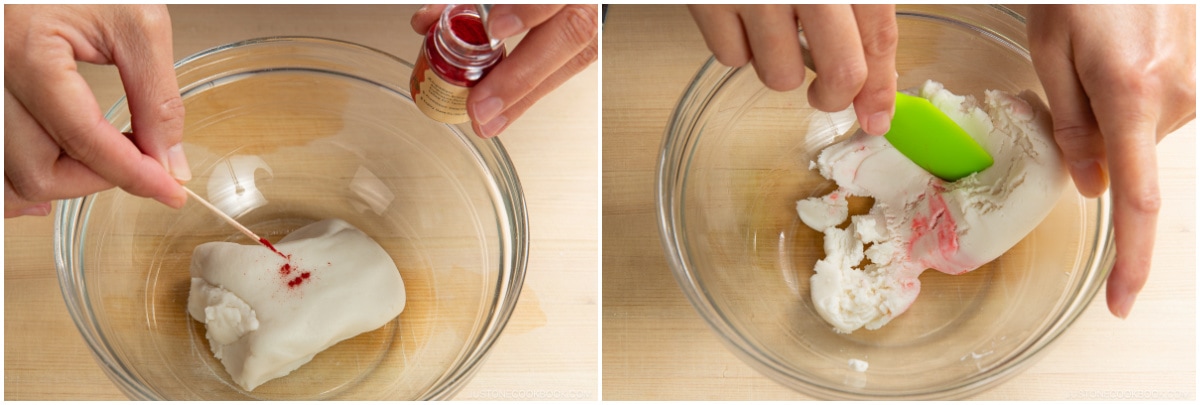
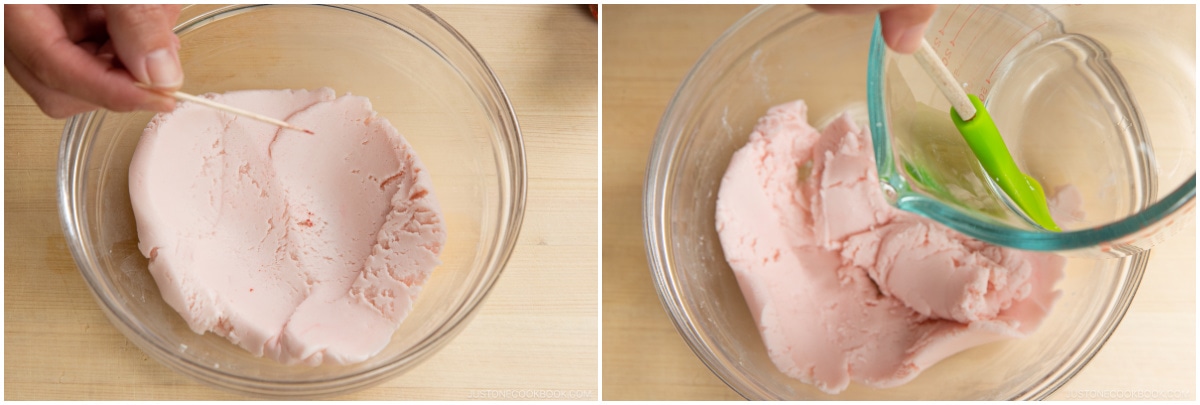
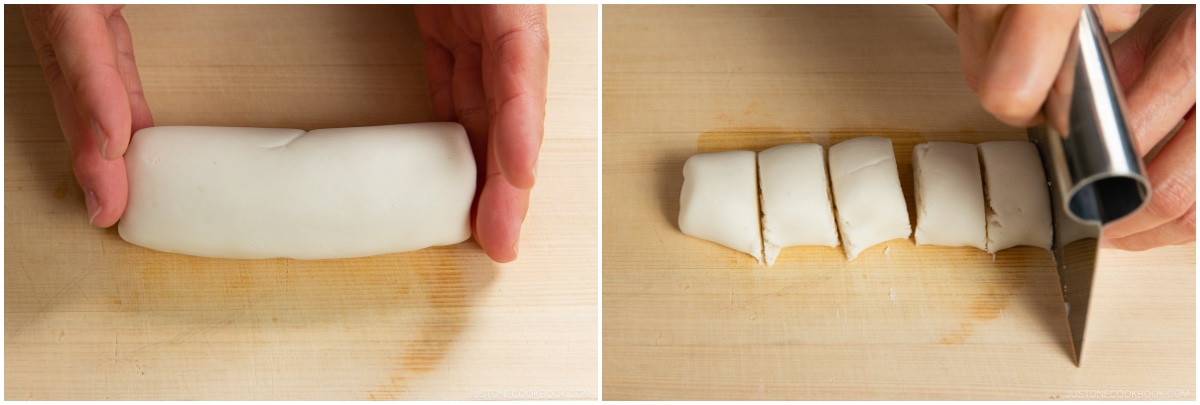
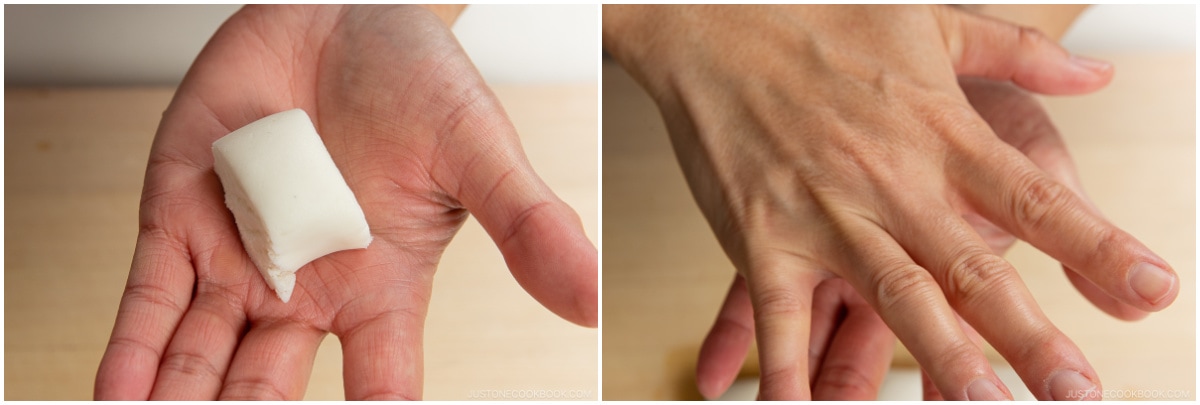
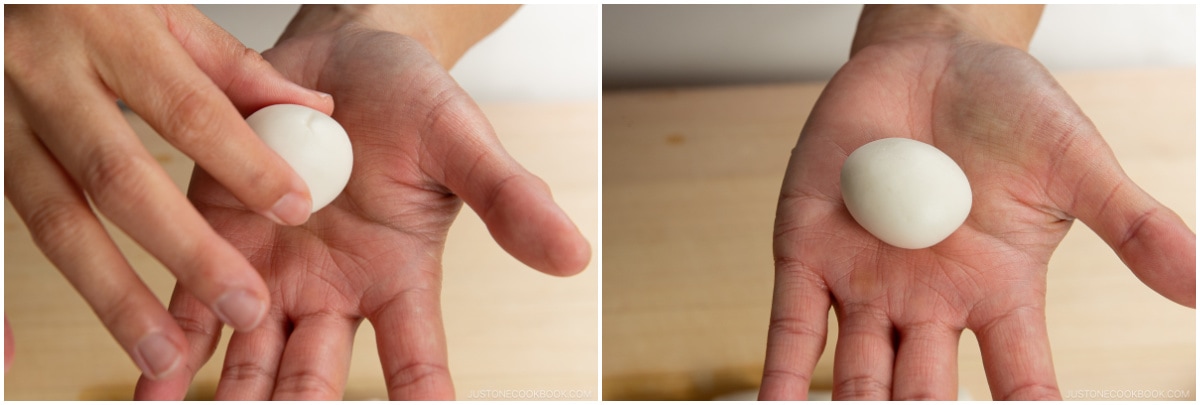
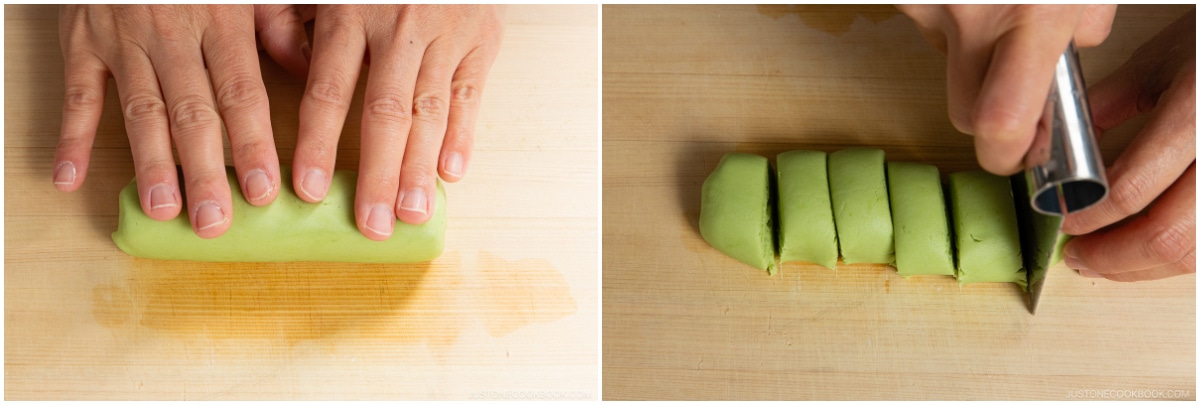
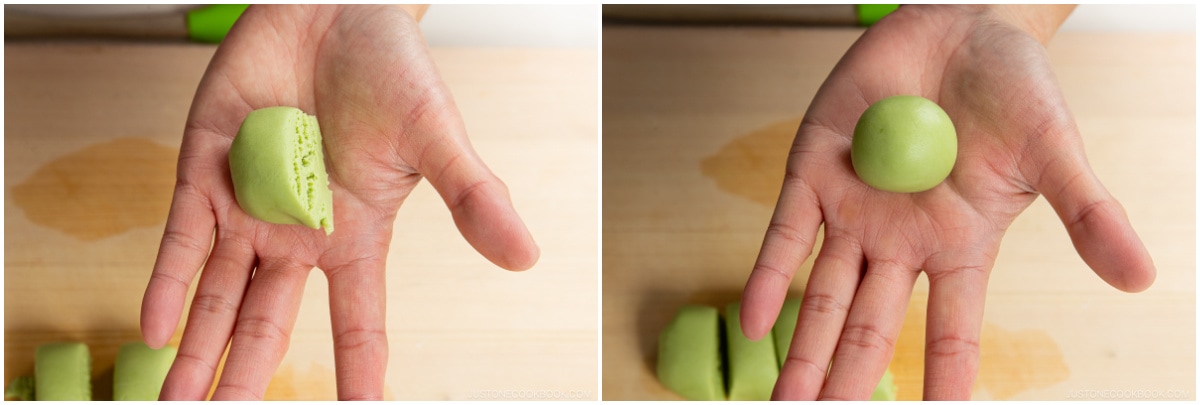
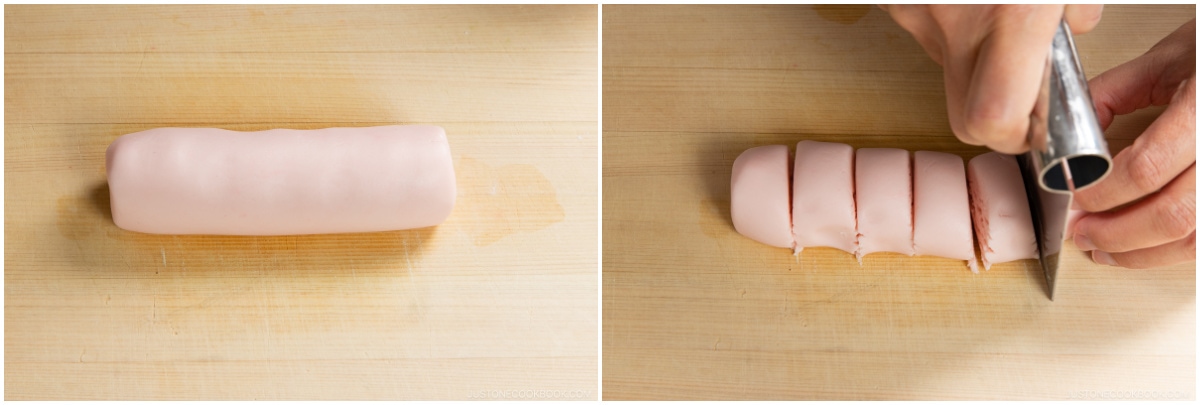
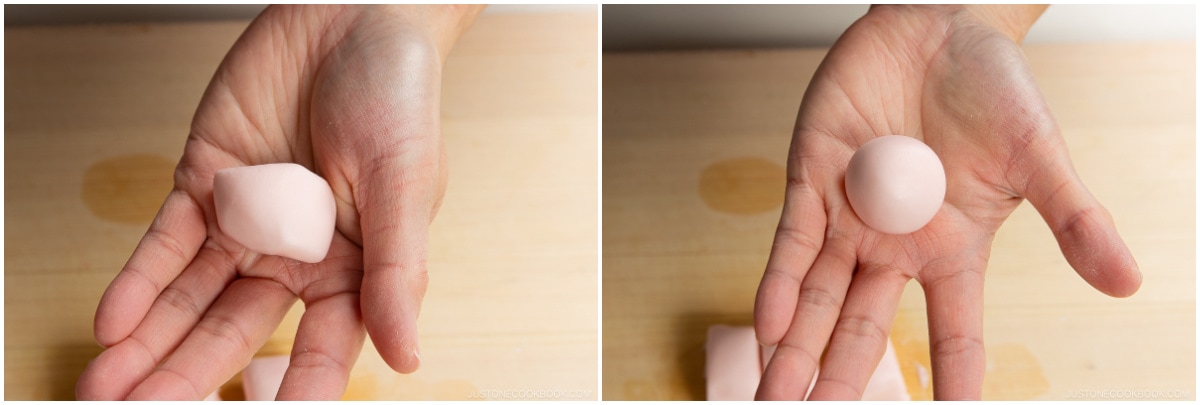
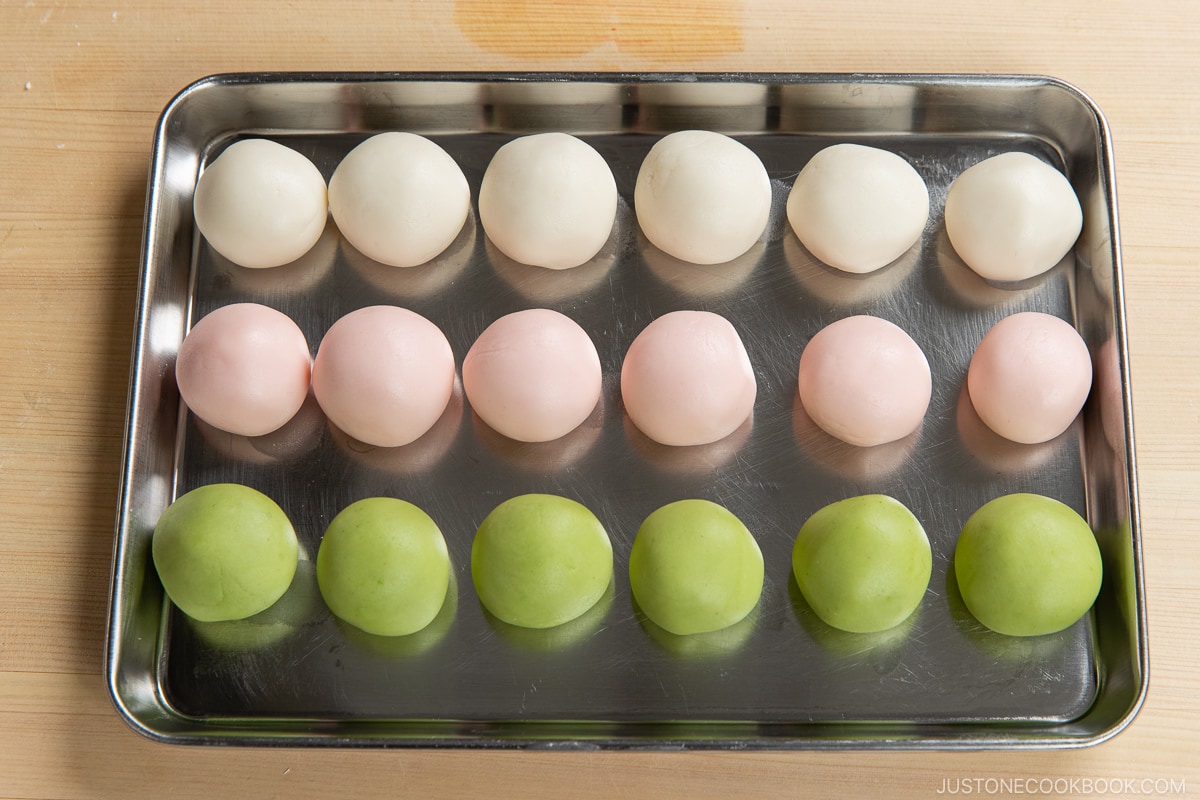
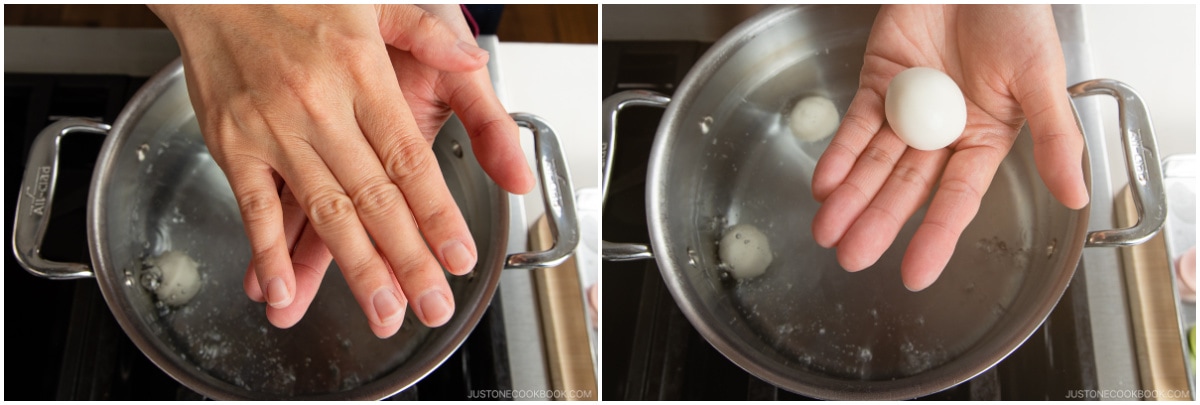
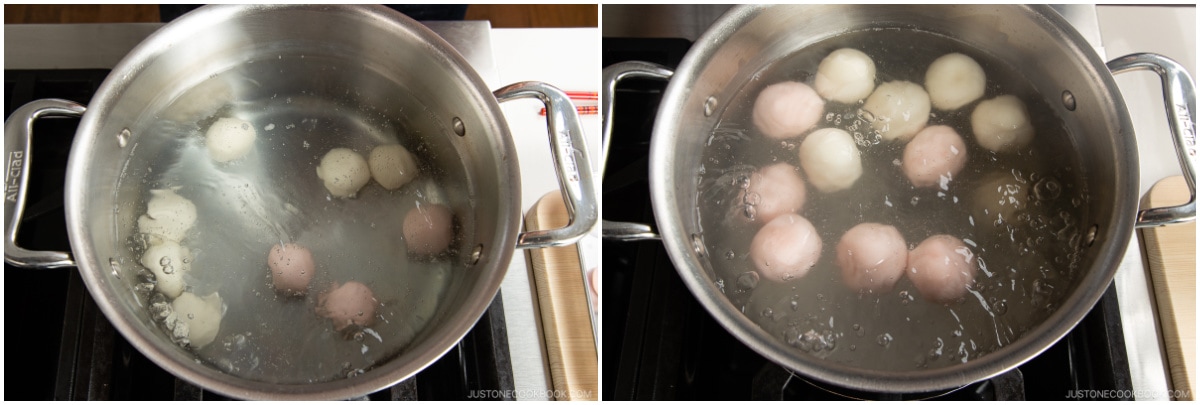
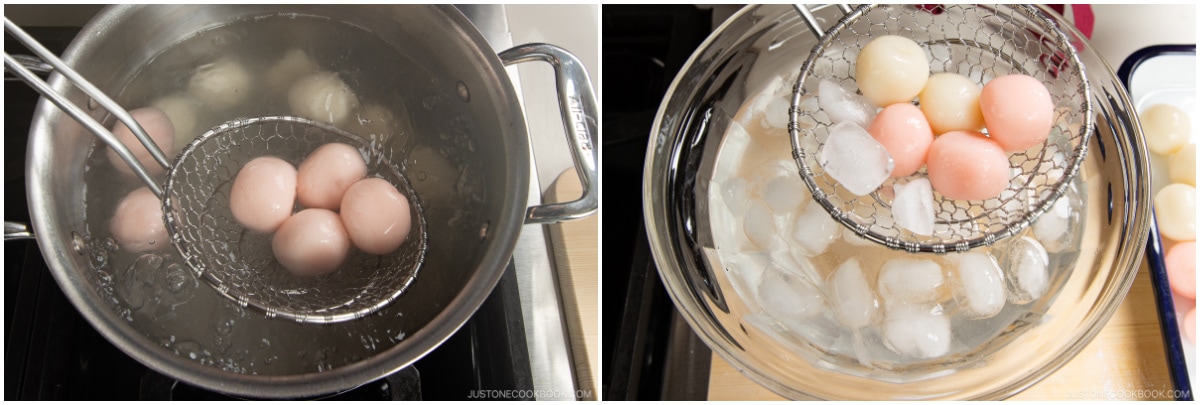
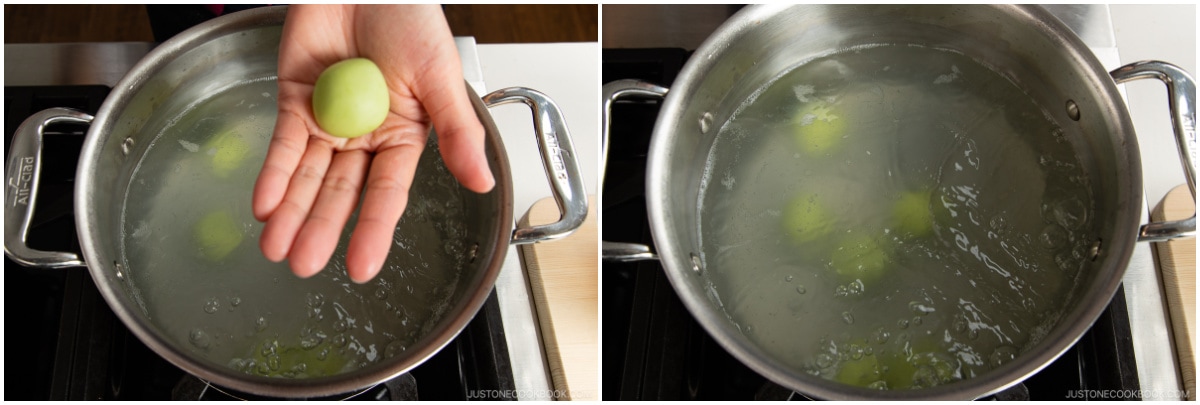
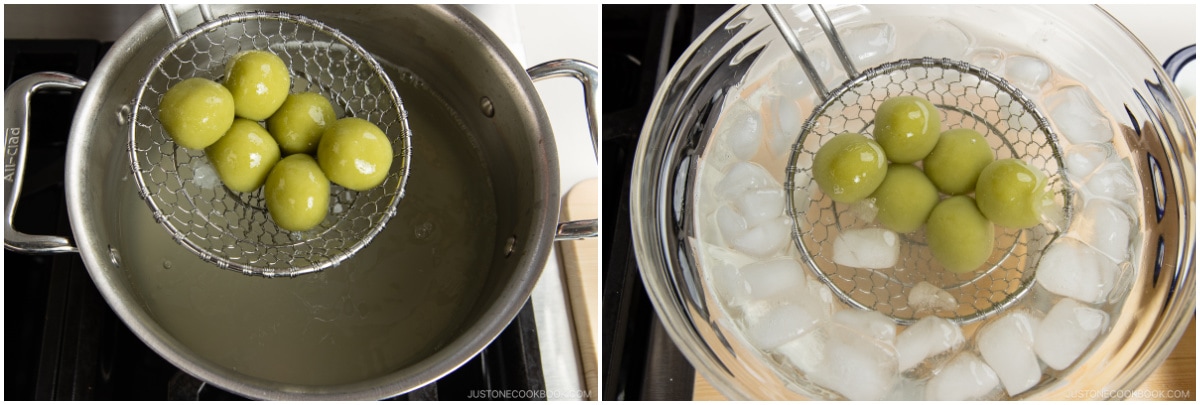
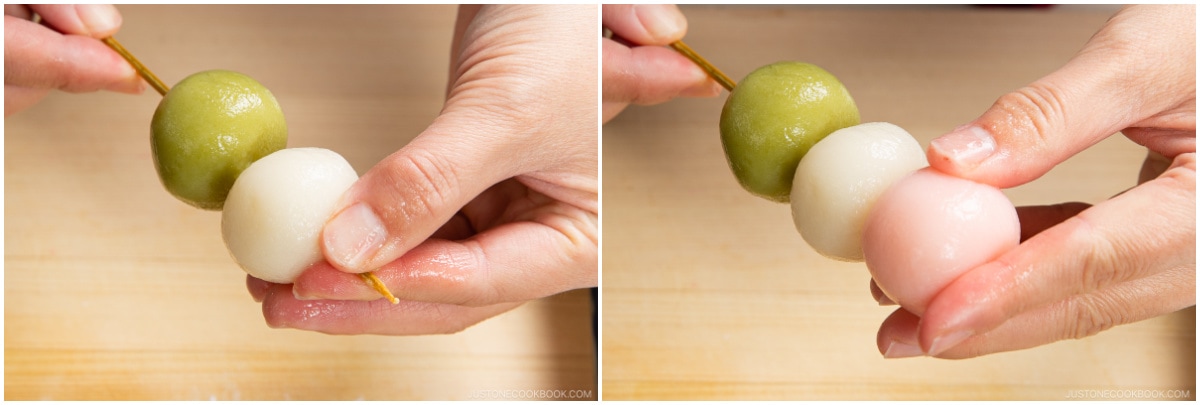
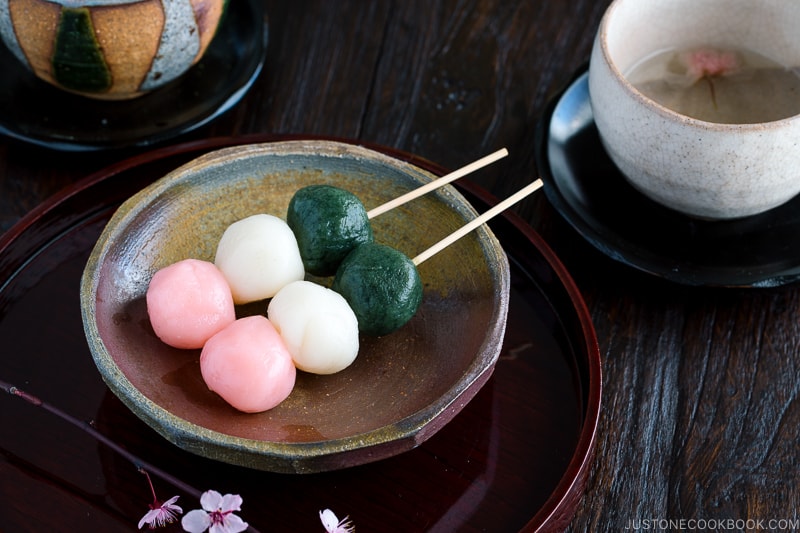

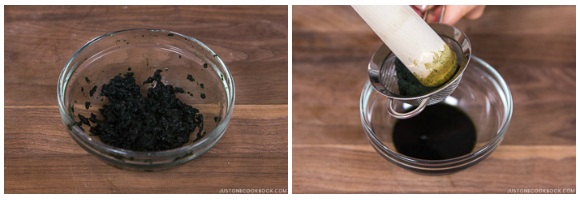











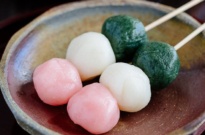
Getting authentic Japanese flour where I am is prohibitively expensive for me, so I used a mix of regular rice flour and glutinous rice flour from my local Asian store. I think I probably added a little too much water at first, because the dough was veeerrry sticky, but I just added more regular rice flour until I got the earlobe texture. They were very nice and I had them under the cherry blossoms at my local park with some anko. But I found they tasted even better the next day after a few minutes under the grill. Will definitely make them again.
Thank you for sharing your experience, Cherry!
We are glad it went well for you and you enjoyed the Dango!🥰
I tried making dango with a less traditional recipe (that used tofu) and it was interesting, but I felt like the texture seemed a bit off from descriptions I had read. I came here because the recipe seemed much more traditional, which I appreciated. However, after my first try I had two big disappointments:
Rather than wasting my tiny bag of Joshinko trying to save the dough, I opted to throw away the first batch. Unfortunately I do not have enough flour to make another batch using this recipe which means I wasted $30 on flour and will have to order flour again in order to try again. As soon as I looked at the shiratamako my gut told me I should put it in the blender/food processor but since the recipe did not call for it I opted to follow the recipe. I really wish I had listened to my instinct and processed it further so it would properly incorporate into the dough.
Additionally, I am unsure why this recipe does not include weights for the dough. I did measure my flour using the spoon-and-level method to be as accurate as possible, but there would be no reason for that if the recipe had weights. I plan to weigh out my flour the second time I make the recipe for my own records, so I am not having to guess at the weight of each cup – since the bags are in Japanese I cannot read them/translate them to proper weights using the nutrition facts.
Hello there! Thank you very much for trying out Nami’s recipe and sharing your feedback.
Just a quick tip: there is a metric box you can click on to see the weight of each ingredient. For this recipe, you will need 100g, which is half of the box you will find. Regarding the difficulty in working with Shiratamako, if you followed Nami’s instructions and used hot water, it should work well. We hope you give it another try!🫶🏻
Hi Nami. You are most definitely my number one site for Japanese cooking and I have tried probably 20 of your recipes, always with success so far, so I very much appreciate you but just wanted to comment that I think maybe the 1833 reference for Toyotomi Hideyoshi’s party might be a little out. I plan to have a crack at these as soon as I next get out to my nearest atari-ya to get the rice flours.
Hi Richard, Thank you for reading Nami’s post and for your input!
It might be hard to believe, yet many resources mention this in Japanese. It’s one of the theories. 😉
https://www.educe-shokuiku.jp/news/shokuiku/dango/
We hope you enjoy making and tasting Hanamidango!🍡